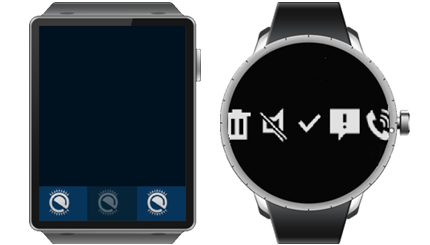Image
This feature is supported in wearable applications only.
The image component can load and display an image from a disk file or a memory region.
For more information, see the Image API.
Figure: Image component

Figure: Image hierarchy

Adding an Image Component
To create an image component, use the elm_image_add() function:
Evas_Object *image, *parent; image = elm_image_add(parent);
Configuring the Image Component
To configure the image component:
-
Disable elementary scaling so that the image does not scale but resizes on both directions:
elm_image_no_scale_set(image, EINA_TRUE); elm_image_resizable_set(image, EINA_TRUE, EINA_TRUE);
-
Use the smooth scaling algorithm to provide a better quality image. It is slower than the default algorithm.
elm_image_smooth_set(image, EINA_TRUE);
-
Preload images without blocking the user interface. This preserves the reactivity of the user experience. The image is loaded in a thread. It can be disabled.
elm_image_preload_disabled_set(image, EINA_TRUE);
-
Rotate or flip the image. In the following example, the image is rotated 180 degrees.
elm_image_orient_set(image, ELM_IMAGE_ROTATE_180);
The following orientations are available:
- ELM_IMAGE_ORIENT_0: No orientation change
- ELM_IMAGE_ROTATE_90: Rotate the image 90 degrees clockwise
- ELM_IMAGE_ROTATE_180: Rotate the image 180 degrees clockwise
- ELM_IMAGE_ROTATE_270: Rotate the image 90 degrees counter-clockwise
- ELM_IMAGE_FLIP_HORIZONTAL: Flip the image horizontally
- ELM_IMAGE_FLIP_VERTICAL: Flip the image vertically
- ELM_IMAGE_FLIP_TRANSPOSE: Flip the image along the bottom-left to top-right line
- ELM_IMAGE_FLIP_TRANSVERSE: Flip the image along the top-left to bottom-right line
-
To keep the original aspect ratio when resizing the image, define how the image fits into the object's area:
// Tell the image to keep original aspect ratio elm_image_aspect_fixed_set(image, EINA_TRUE); // Then let the image fill the entire object elm_image_fill_outside_set(image, EINA_TRUE);
In this configuration, part of the image can go outside the object. If the elm_image_fill_outside_set() function is set to EINA_FALSE, the image stays inside the limits of the parent object.
Using Image Callbacks
The image component emits the following signals:
- drop: The user drops an image typed object onto the object in question. The event info parameter is the path to that image file.
- clicked: The user clicks the image. event_info is NULL.
To register a callback when a user clicks on the image:
{
evas_object_smart_callback_add(image, "clicked", clicked_cb, data);
}
// Callback function for the "clicked" signal
// This callback is called when the image is clicked
void
clicked_cb(void *data, Evas_Object *obj, void *event_info)
{
dlog_print(DLOG_INFO, LOG_TAG, "Image clicked\n");
}
| Note |
|---|
| Except as noted, this content is licensed under LGPLv2.1+. |

